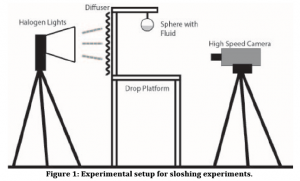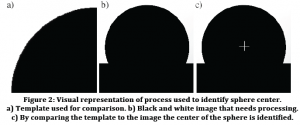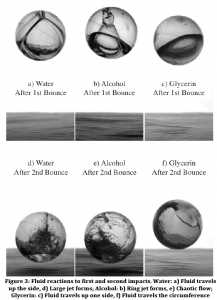Robert Klaus and Dr. Tadd Truscott, Department of Mechanical Engineering
Sloshing is a very common phenomenon that we encounter everyday. Anytime that a liquid is enclosed within a moving container there exists the potential for sloshing. In some cases, such as trucks & ships, the sloshing of the fluid can produce undesired vehicle motion and even lead to catastrophic results. On the other hand, street hockey balls use fluid sloshing to help mitigate the rebound inherent to elastic spheres. In this research, high-speed imaging has been used to capture the sloshing motion and understand its effect on the rebound of partially filled, hollow, elastic spheres.
In order to produce the high quality images necessary for data processing, an aluminum frame and acrylic platform was designed and constructed. Halogen lights were directed through a diffuser and used to provide the necessary backlighting. Each sphere was suspended over the platform until the fluid inside reached a quiescent state. Upon doing so, the sphere was dropped and its motion captured with a Photron A3 High Speed Camera (see Figure 1).
After the images were collected, software was developed, based on the Matlab platform, to track the sphere’s position through time. A 2D normalized cross-‐correlation algorithm compared each image to a template and determined the pixel location of the sphere’s center. In order to improve the robustness of the algorithm, the images were reduced to only black and white pixels. A threshold that colored the sphere black and left the background white was obtained after some trial and error. Assembling the center position’s from all the images and correlating them to the frame number obtained the sphere’s position through time. Figure 2 is a visual example of how the sphere position was obtained using the binary images.
One of the most interesting results was how widely varied the motion of the fluid inside the sphere was with respect to changing fluid properties. Trials using water resulted in the first impact forcing fluid up the sides leaving a cavity in the center (figure 3a). On the second impact the cavity collapsed forming a large jet in the center (figure 3d). In the alcohol trials a hollow ring jet was formed on the first bounce (figure 3b) and collapsed into chaotic flow on the second (figure 3e). By contrast, the first impact of the glycerin filled spheres also traveled up the sides, but far less distance and often up only a single side (figure 3c). On the second impact the fluid rushed back down and circled around the circumference of the ball (figure 3f).
Although the fluid reactions vary greatly, the rebound responses are very similar. Regardless of the fluid used, the first rebound height was barely affected and the second was greatly suppressed. During the test both fluid density and viscosity were varied, but there was no noticeable difference in the rebound suppression characteristics. On the other hand, the rebound was significantly affected by how much fluid was used. This suggests that the amount of fluid contained in the sphere, rather than the type of fluid, has the greatest effect on rebound suppression.
The results of this research were presented in a poster session at the American Physical Society’s Division of Fluid Dynamic’s annual conference in Long Beach, CA. The full results of the study are also being prepared for publication in the peer-‐reviewed journal Experiments in Fluids.
Without a doubt the opportunity to perform research as an undergraduate has been an invaluable experience for me. As a new graduate student, I have found that I can draw on the lessons learned in this research to help solve the challenges I now face.



